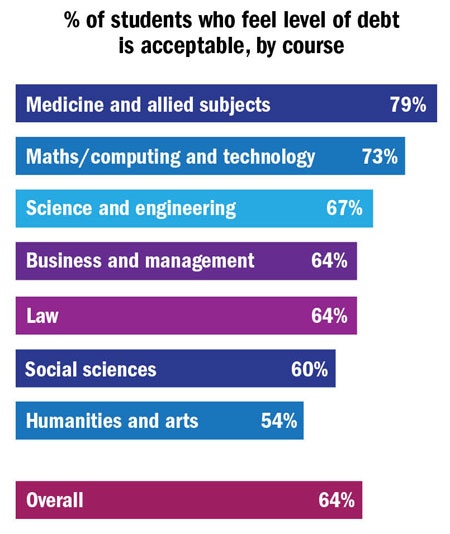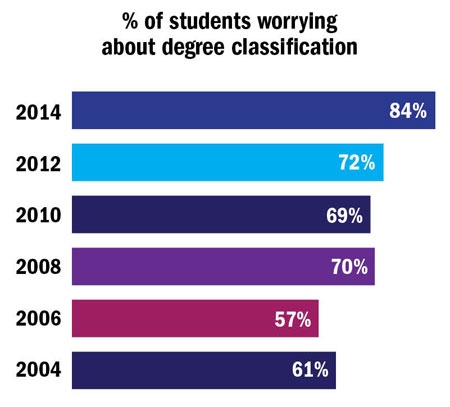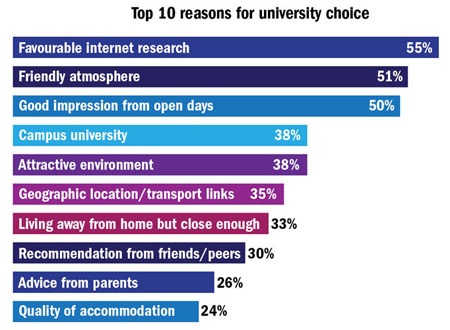Source: Getty
Most students still feel positive about their investment in their education despite the higher tuition fees faced by first- and second-year students at university in 2013-14, the Sodexo-Times Higher Education University Lifestyle Survey reveals.
About a quarter of students (26 per cent) said that the amount of debt they expected to incur was definitely acceptable as an investment in their future career, while 38 per cent said it probably was.
But dissatisfaction levels rose sharply compared with the previous survey in the 2011-12 academic year. This time, 28 per cent of students said that their university study would not be worthwhile in the long run – an increase of 10 percentage points on the 18 per cent who felt this way two years ago.
Those studying humanities and arts were most troubled by value-for-money concerns: 36 per cent stated that their expected debts on graduation were not a worthwhile investment – more than twice the rate of those on courses in medicine and allied subjects (17 per cent).
Students at older universities were less likely to worry about debt levels than those at post-1992 universities, with 25 per cent viewing their investment in education as unacceptable, versus 30 per cent at newer institutions.
Expected debt levels under the £9,000 fees system have also changed many students’ plans, with 23 per cent saying that future debt had affected their career choice, up from 15 per cent who said this two years ago when fees were lower.
Unsurprisingly, predicted debt levels rose massively among students paying £9,000 annual tuition fees. Some 23 per cent of first-year students expected to be £40,000-plus in the red on graduation compared with just 2 per cent of those in the third year – the final cohort of students to pay £3,375 a year under the old fee regime.
Some 58 per cent of respondents now believe that they will leave university with debts of more than £20,000 – nearly double the proportion (30 per cent) two years ago. In 2004, when fees stood at about £1,000, only 2 per cent of students thought this was a possibility.
Click here to view the full report

Under pressure: degree class tops anxiety list
The need to achieve a “good” degree is more pressing than ever as students pay higher tuition fees, the survey suggests.
Securing their desired degree classification was a worry for 84 per cent of students in 2013-14, up from 72 per cent who were troubled by academic concerns two years ago.
In 2003-04, only 61 per cent fretted about achieving a certain degree class, indicating the increasing pressure to achieve at a 2.1 before entering the job market.
Other major student worries include balancing academic, social and work commitments (69 per cent mentioned this) and coping with a heavy workload (61 per cent admitted this).

Selective reasoning: internet research and asking for advice
Students are increasingly asking friends, family and teachers for advice when picking a university in the era of £9,000 fees, the survey suggests.
Some 30 per cent of respondents said that friends were a key source of information, up from 22 per cent in 2011-12, whereas 26 per cent listened to their parents, a larger proportion than the 12 per cent of two years ago.
Nearly a quarter (23 per cent) were swayed by their teachers’ advice, compared with 14 per cent in 2011-12 – a trend that may worry some universities as schools are sometimes criticised for their advice on where to apply.
Overall, the internet is the most-cited influence on student choice, with 55 per cent saying that they partly based their decisions on information gleaned from websites, up from per cent two years ago.
When researching online, applicants turned to universities’ own website most often (83 per cent), but also to independent online guides such as Which? or to university league tables (49 per cent).
The most-mentioned reason for going to university was to improve job opportunities (76 per cent), followed by improving knowledge in an area of interest (63 per cent) and enhancing salary prospects (62 per cent).

Other findings: wi-fi and lunch
The ability to access the internet via wi-fi is important to students when seeking a room in university-run accommodation, with 24 per cent declaring this their top priority. Only 2 per cent said that having a good student bar or cafe was a major concern.
Only 6 per cent of undergraduates currently view lectures delivered online regularly, but 31 per cent said that they wanted to see more lectures online. Just over half (55 per cent) were happy with the current arrangements for teaching. Three-quarters (76 per cent) said that they would like their normal lectures recorded for viewing at another time.
More than half of students (51 per cent) skip at least one meal a week, while one in 10 misses about one meal a day during an average week.
Moving out: living the student life
The rapid rise in the number of stay-at-home students forecast when £9,000 fees were introduced has not happened, the survey suggests.
The proportion of students living with their parents to minimise costs has increased only slightly – up to 19 per cent from 18 per cent two years ago.
However, students are studying closer to home than before. A third of students said that the ability to live away from parents but close enough to get family support had influenced their choice of university, up from 29 per cent in 2011-12.
Some 35 per cent also said that transport links to home mattered when picking an institution.
The most popular type of student digs (34 per cent) remained a privately rented flat or house.
Sobering thoughts: less clubbing, more nights in
Nightclubs and bars that once heaved with students are half full or empty most evenings since £9,000 fees were introduced, it has been claimed.
And this year’s survey suggests that the anecdotal evidence that students now shun a night out on the town in favour of study may be true.
A third of students (33 per cent) say they do not drink at all, up from 23 per cent in 2009-10 and 26 per cent in 2011-12, whereas 40 per cent limited their drinking to just once a week.
In addition, the proportion of students socialising more than five hours a day on average has fallen from 33 per cent in 2005-06 to 10 per cent in 2013-14.
Of course, not all students are so self-disciplined: 28 per cent drink more than once a week, of whom 2 per cent drank daily and 20 per cent two or three times a week.
But it seems that club nights or evenings at the union bar have now been replaced by more nights in with friends, with 50 per cent preferring to stay at home or to visit friends to socialise compared with 26 per cent who would rather go out.
But the decline of student clubbing might not lead to students devoting more time to their studies as only 8 per cent of students said they spent 11 hours or more in the library every week.
Note: A total of 2,000 students were interviewed in November and December 2013 for the survey.
Register to continue
Why register?
- Registration is free and only takes a moment
- Once registered, you can read 3 articles a month
- Sign up for our newsletter
Subscribe
Or subscribe for unlimited access to:
- Unlimited access to news, views, insights & reviews
- Digital editions
- Digital access to THE’s university and college rankings analysis
Already registered or a current subscriber?





